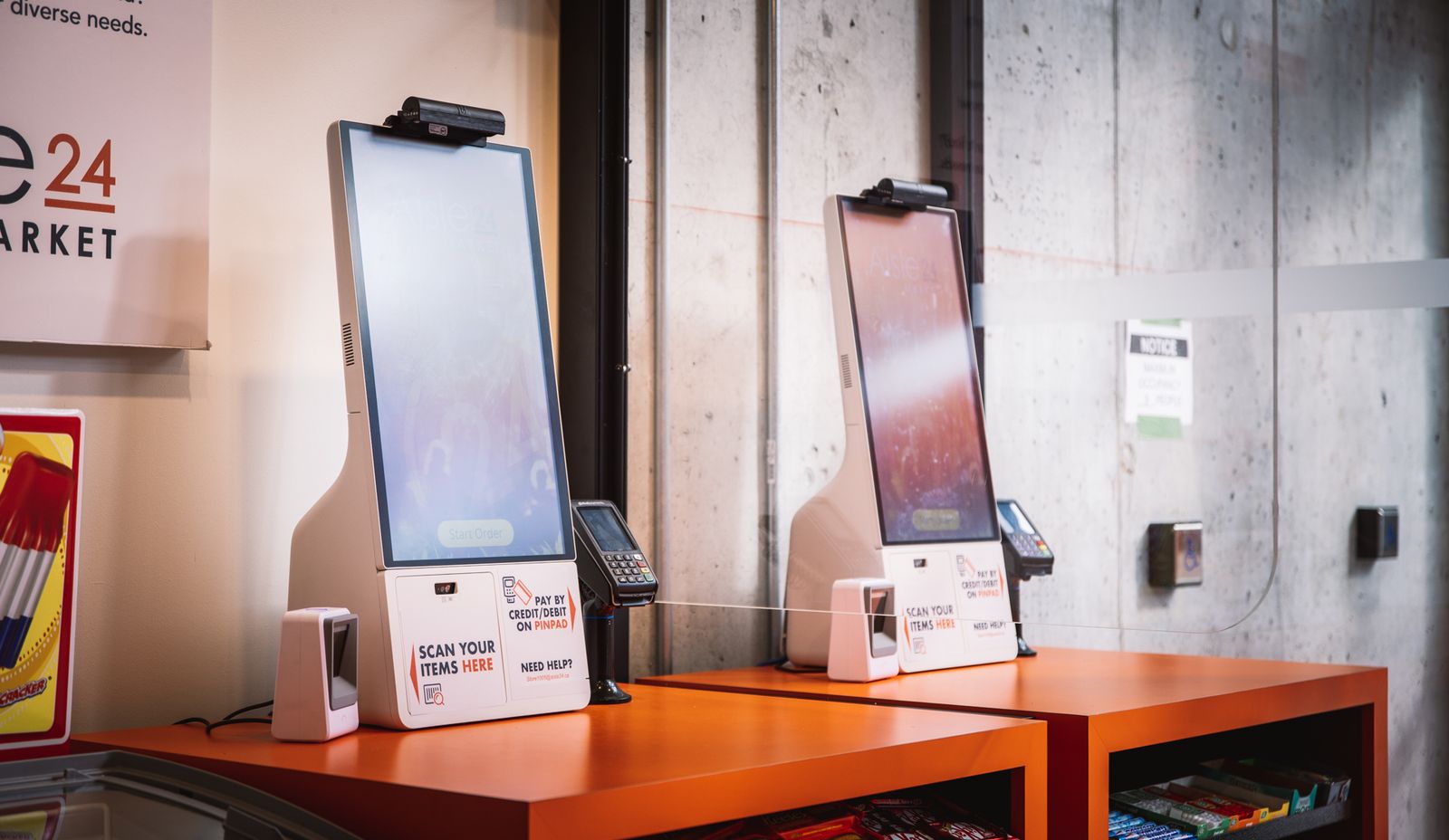Burgeoning Canadian cashierless chain Aisle 24 is capitalizing on the opportunity to convert underutilized space in residential buildings into 24-hour self-service markets that are a cross between a small-format grocer and convenience store.
Customers use the Aisle 24 app to access the store and then use in-store kiosks to pay — an approach aimed at appealing to the company’s target Gen Z and millennial shoppers, who want to get in and get out quickly.
“Saving their time is important to them. … Get in, get out, get on with your day — that is what we’re about,” said co-founder and CEO John Douang, noting that customers will often complete their visits within minutes.
Aisle 24’s self-service stores are popping up in Toronto and other major cities in Ontario and Quebec, and the startup is eyeing expansion into the U.S. Currently, Aisle 24 has more than a dozen locations open and roughly a dozen more under construction, with a queue of 96 locations across Canada, according to Douang.
Last year, Aisle 24 added another format that uses traditional ground-floor retail spaces that are accessible to the public.
As Aisle 24 eyes expansion into the U.S., here’s a look at how the chain operates its stores and the ways that it’s innovating its model at a time when the lines are blurring between grocery, restaurant and convenience offerings.
The interior of an Aisle 24 store.
Permission granted by Aisle 24
Building on c-store, tech experience
Brothers John and Josh Douang and Marie Yong, John’s wife, founded Aisle 24 in 2015, spurred by what John Douang said was a personal need to quickly get items, like cream for coffee, while living in a condo in his 20s.
Aisle 24’s concept also ties back to their upbringing: The Douangs are sons of a family that owned a convenience store in Toronto, which provided lessons on how to run a small business, Douang said.
Aisle 24 offers two store formats. Its Resident Markets occupy space within residential buildings, typically ranging from 300 to 900 square feet, while its Community Markets are designed for standard commercial real estate, spanning 1,000 to 1,800 square feet.
The locations within residential buildings can vary depending on where there’s available space, such as the main level, basement or amenity area. The Community Markets format, which was launched in June 2021, typically occupies traditional ground-floor retail space and provides more visibility to walk-by and drive-by traffic.
“We do see that the Community format is the future of Aisle 24. The Resident format is great, but it’s really supplementary,” Douang said, adding that the company is targeting the Community Market format to higher-density areas.

Aisle 24 carries a variety of grocery and convenience items.
Permission granted by Aisle 24
Aisle 24’s stores carry standard grocery offerings, like meat, pasta and produce, and do not carry age-restricted items, like alcohol, since there are no front-end employees to verify the purchase. Roughly 10-15% of each store’s assortment is crafted to meet its customer demographic, Douang said: “We do some statistical research and determine what age range, what’s the median income, what’s the ethnic background, and then we’ll craft some of the products.”
For example, a store in Toronto’s Liberty Village neighborhood with a strong consumer base of Gen Z and millenial shoppers influenced the decision to add more local brands.
The change was successful — “It did amazingly well and now this store is our top-performing store” — and is now prompting Aisle 24 to roll out more local and small brands across its store fleet, Douang noted.
To boost consumer engagement, Aisle 24 is working on customized promotions based on past purchase history to create a more personalized experience, Douang said.

Aisle 24 customers can pay using digital kiosks.
Permission granted by Aisle 24
Operating a store that’s always open
Aisle 24’s model relies on franchise operators who travel between stores, spending a few hours at each one at least three times a week for cleaning and stock replenishment. Some of the busy stores have operators on-site every day for a few hours. The founders wanted to avoid creating a business where operators would have to work 14-hour days and close the store in order to take a vacation.
“When we developed the concept, it was very key for us to create a process whereby the operator doesn’t need to be there all the time,” Douang said.
While there are shoppers who want in-person interactions with store workers, Douang said Aisle 24’s target customers tend to value a quick shopping trip, and that the company provides live agents and chat support.
“We find that our membership base, they want to chat with us. They don’t want to call. They don’t want an email. They want instant chat,” he said.
To boost operational efficiencies, Aisle 24 uses electronic shelf tags and inventory stocking technology, said Douang, who spent 12 years in the tech industry. The digital shelf labels not only allow for workers to control pricing remotely but also look sleeker to customers, he said.
Douang said that requiring shoppers to unlock the store with an app helps prevent theft, since the company knows who has entered and exited the building. The company has also invested in security infrastructure. It uses Axis Communications’ turret-style and height-strip cameras to monitor customers in the stores. That technology also allows Aisle 24 to find out how heavily trafficked the stores are, according to an Axis YouTube video.
Still, Douang admitted that occasionally a person will slip in behind an Aisle 24 member as they access the store.
When creating an account on Aisle 24’s app, customers have to upload a photo and attach a card payment to their account, which Aisle 24 will validate on a regular basis. The company’s security recovery process has led to credit card charges for 95% of the items that go missing, Douang said.
The Resident Markets often have an extra layer of security from the residential buildings’ own security and 24-hour concierge.

Exterior of an Aisle 24 store.
Permission granted by Aisle 24
Crossing the border
By mid-2023, Aisle 24 is set to have a national presence in Canada with locations in British Columbia, Alberta, Ontario, Quebec and Nova Scotia, Douang said.
“There’s a lot of interest for us to be there in the U.S. We are planning for it,” Douang said, noting its U.S. entrance will likely get pushed back from mid-2023 to 2024 due to concerns about a recession.
The founders have seen customer behavior vary in Canada. In Toronto, for example, shoppers tend to rely on public transit and walking while over in Calgary, Alberta, it’s more common to drive to shopping plazas, Douang said, noting there will likely be a learning curve to understanding what consumers in U.S. markets want.
Retailers in Asia, in particular, have seen success with similar formats and there’s a lot of experimentation in Europe with cashierless shopping, noted Anne Mezzenga, a Target veteran and co-CEO of retail blog Omni Talk.
Self-service grocery is especially helpful for rural communities that have limited access to groceries, said Stewart Samuel, program director with IGD, noting that some companies in Scandinavia are experimenting with this model. Along with rural areas, Samuel said there’s a “huge opportunity” to create small-footprint convenience offerings detached from gas stations in urban areas.
“Overall, a lot of U.S. cities don’t have a lot of grocery offers in some of those core downtown areas,” Samuel said.
Mezzenga sees an Aisle 24-type model as a step toward a more convenient and more operationally friendly model for convenience stores.
In the U.S., Amazon is currently leading the cashierless grocery frontier with its Just Walk Out technology, but other grocery and convenience chains as well as tech firms are expanding their use of smart checkout options. Choice Market, a Colorado-based grocery/convenience store chain, unveiled a computer-vision system last year and recently opened a 24-hour self-service store at The University of Colorado.
The self-checkout kiosks that Aisle 24 relies on can be a good fit for short-term use cases, convenience models and stores focused on grab-and-go items — but unless there are cameras attached to the self-checkout machines, shrink can become a problem, Mezzenga said. In 2023, she is expecting to see retailers test more Costco– and Sam’s Club-esque controlled entry for customers to reduce shrink and more efficiently run checkout-free retail like scan-and-go and self-checkout.
“I think the challenge for the self-kiosk for me is … it’s not an inexpensive investment for them to make. The self-checkout still leaves a lot of room for error and shrink,” Mezzenga said.



